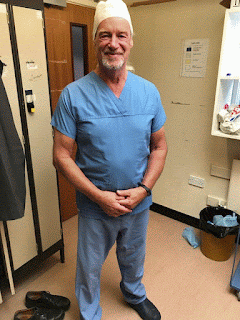Some 34 years ago, I moved to
Manchester to start a new job as a commissioning nurse for the North West
Regional Forensic Adolescent Service (Gardener Unit). It was the only NHS
funded and managed forensic mental health service for young people. This
service was based in a purpose built secure unit on what was once known as
Prestwich Hospital. Prestwich Hospital was built as an asylum (in the true
sense of the word) way back in 1851. By 1900, it had grown into the largest
mental health hospital in Europe. 84 years later when I arrived, it was a much
smaller hospital, largely made up of very specialised mental health services.
These days it provides acute and community-based mental health services to many
parts of Greater Manchester, the North West and beyond.
The Gardener Unit was a
relatively small medium secure unit. The latest data (2015) reveals that in
England, there were 1,450 young people in secure settings at any one time. Over
300 of these young people were in secure mental health settings, the rest in
what is termed welfare secure settings. However all these young people have
clearly established (and often significant) mental health needs. Those young
people in secure in-patient mental health units such as the Gardener Unit will
present with the highest risk of harm to others. Typically these are young
people who have committed a serious or grave crime. They are often vulnerable,
have challenging behaviours, and self-harm. Secure settings such as the Gardener
Unit have both high levels of physical security as well as high levels of
procedural and relational security.
My time there was a truly
wonderful period in my career as a nurse, service manager and ultimately an
academic. I worked there for 10 years before taking up my first University job
at Manchester Metropolitan University, moving to the University of Salford 10
years later. Last week I was reminded of my time at Prestwich. I read the background
to the public inquiry which began last week, into the contaminated blood
scandal that affected many thousands of people. It is estimated that some 3000
people have died as a direct consequence of being given contaminated blood
products. Thousands of patients were
given blood products infected with hepatitis and HIV during the 1970s and
1980s. One of these people was one of the first patients admitted to Gardener
Unit. They were someone who had been given a contaminated blood product (Factor
VIII) as part of their treatment for haemophilia. As a consequence of this they
had developed HIV.
Back in 1984, little was known
about HIV and AIDs. There was a societal climate of fear, discrimination and
stigma associated with HIV and AIDs. This was mirrored in part by those staff
working in the Gardener Unit. We were ignorant and sometimes this showed in our
approaches to this young person. We simply didn’t know enough about the disease
to use science and evidence-based knowledge in dispelling the myths and
misunderstandings. Whilst this young person had committed a grave crime, the
fact remained that they were simply an innocent victim, bewildered, and
vulnerable. It didn’t help that their family, friends and home town was some
300 miles away from Manchester.
Fast forward to 2018, and we know
a lot more about the prevention, and treatment of HIV and AIDs. The blood
product risk has been eliminated and the greatest risk of contracting HIV today
is through sexual relationships. NHS England, currently has a trial of the
preventative medication PREP, (perhaps ironically, a pill with a similar shade
of blue to Viagra). PREP is a pre-exposure prophylaxis, and is a daily pill
that disables HIV before it can gain a stranglehold in the body. The pill is
being made available to those at risk of contracting HIV, in the main young gay
men. Trials suggest that it can cut the risk of becoming infected by up to 86%.
Before the trial began, people buying the drug privately have been linked to
the first ever fall in new infection rates in gay men.
However, there is no room for complacency. Here in Great Manchester, there are more than 5,000 people living
with the disease (three times the national average). There are still some 300
new cases of HIV every year. The Greater Manchester Mayor, Andy Burnham has recently
committed £1.3m to help stop the spread of HIV in the region. The city is set to join a growing global network of cities working together to stop the spread of
the virus. It is a commitment only made possible through the devolution of
funding and responsibility for managing the health and social care services to
the region.
I have often wondered what
happened to all those young people who were the early patients at the Gardener
Unit. I do know that working with troubled young people was as much a privilege
as it was at times a challenge. I do also know that for me, working with such young
people brought to life the words of Hippocrates ‘cure sometimes, treat often,
comfort always’.



